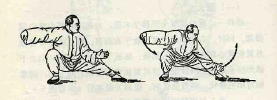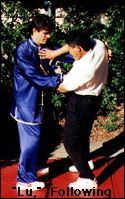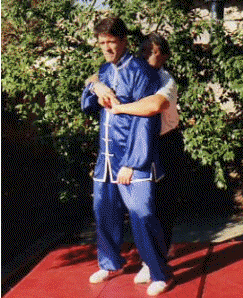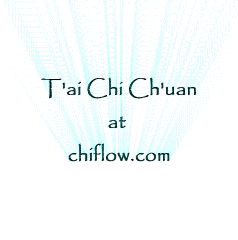
Yang style Tai Chi Chuan
(Yang Style Taijiquan)
Part 1
Yang Luchan and the Early Development of Yang style
Image: Example of Yang Style Taijiquan martial application of Single Whip.
Images: Yang Chengfu - Fair Lady Works at the Shuttles. The posture is illustrated from the Yang form and an application image is presented.
Yang Style is often recognized as the most popular of the five major styles of Taijiquan practiced in China today. Yang Style has gone through a host of changes and additions in its 150 year history. There is a vast range of variations and interpretations of the style.
Yang Style was created by Yang Luchuan and branched off of the Chen style teachings of Chen Changxing. The sons and grandsons of Yang Luchuan continued to change the Yang style. Wu style branched off from Yang style a bit later. The various teachers of Yang style have created many more branches. There has also been an emphasis on T'ai Chi Ch'uan as only a health exercise by some of these teachers.
|
1. Yang Luchan
Yang Luchan Yang style T'ai Chi Ch'uan was created by Yang Luchan (1799 - 1872), also known as Fu Kwei, during the Qing Dynasty (1644 - 1911). It is unlikely that he called the art that he practiced T'ai Chi Ch'uan. Yang Luchan was a native of Yongnian County (and near present day Handan City) in Hebei Province. He was born into a peasant family, hauled water for a living, and was not formally educated. He had studied Erlang Quan in his village. At one point, Yang Luchan worked as an apprentice in the Taihedang Apothecary in Yongnian County, which was managed by Chen Dahu from Chenjiagou (Chen Family Village), Wenxian County, Henan Province. Legend has it, that one day, some bandits attempted to rob the store by strong - arming the attendants, and Chen Dahu, the manager, confronted the bandits. With a sort of force that Yang Luchan had never seen before - and didn't recognize - Chen warded off the attack, and sent the would be attackers to the ground or out the door of the store. In some accounts Yang is said to have described what Chen did as appearing to use the force of one finger. |
2. Chen Village Yang was eager to learn this skill, but the apothecary manager said that it was necessary to study with someone else. The modest Chen Dahu referred Yang to Chen Changxing, a legendary fourteenth generation Chen Family member in Chenjiagou. Chen Dahu encouraged Yang to go, but warned him that Chen Changxing would test him and might not ever be willing to teach him. Further, even if Chen Changxing would accept him as a student, the art would take years to learn.
Yang Luchan did menial work for some time after his arrival in Chen Village. He may have been an indentured servant. Some texts suggest that the Chen family practice of Taijiquan was closed at that time to members outside the family, but that wasn't necessarily true. However, it was not a regular occurrence for an outsider to have the opportunity to learn directly from a high level Chen family teacher and to be taught the full system in depth. There were many people in the Chen village area who imitated the Chen family style. However, the Chen family had its own practice methods which they regarded as unique and held in secrecy - including the internal practice of Chen style.
|
|
3. Chen Changxing At the this time, Chen Changxing liked practicing outside in a garden area. He conducted his teaching of family members there as well. Yang Luchan began following Chen Changxing's teaching as best as he could from behind nearby bushes. Reports are that Chen was amused by this admirer who was not only poor at hiding, but at trying to imitate Chen's movements as well. It should be noted that Chen Changxing was a pivotal figure in the history of Taijiquan. He was not just another link in the transmission of Chen style across the generations. Chen Changxing was the teacher who organized the Chen style into two sets (Yi Lu and Er Lu). He was one of the three prominent 14th generation Chen family members that changed and advanced the art of Chen Taijiquan more than it had at any time since Chen Wangting. It is very likely that Chen Changxing practiced the art in a much slower manner than the descendants of Chen Village we often see these days. With a slow pace, correct body structure and relaxation, circles emerge naturally. Chen Changxing's actions were reported to be less snappy than his brothers or contemporaries. I believe that the problem Yang Luchan had as he followed Chen Changxing from the bushes did not reflect his skill as as mimic, but that he could not see Chen's internal practice. Chen Changxing eventually accepted Yang Luchan as a student. Legend has it that after a few months of instruction from a distance, Chen felt that Yang was learning more about the internal practice than family members that were studying in Chen Changxing's presence. |
4. Finding Another Way to Engage External Force Some Chen Changxing is reported to have developed a very internal approach to Chen style. This emphasizes finding stillness within movement, and softness within stillness. This approach leads to martial applications that start with neutralization. The nearly effortless power that Yang Luchan first observed in the Apothecary shop in Yongnian is a manifestation of years of commitment to finding a soft, flexible and effective response instead of meeting the opponent's force head on.
|
|
5. Yang Luchan After Chen Village After nearly two decades of study with Chen Changxing, Yang Luchan returned to teach in his birthplace in Yongnian County. Those who were exposed to what Yang was teaching began to refer to Yang's Taijiquan as Hua Quan, Neutralizing Fist, or Mian Quan, or Soft Fist. Yang Luchan's first group of students included Wu Yuxian, whose family owned the building that housed Chen Dahu's Apothecary shop. Wu Yuxian was also fascinated by T'ai Chi Ch'uan and he became Yang Luchan's most famous student from this period. Along with his brothers, Wu Cheng Qing and Wu Ru Qing, Wu Yuxing financed the space and organized Yang Luchan's early classes. It is significant that we know very little about any other students that Yang Luchan may have had during this time. It is also fairly certain that Yang Luchuan's practice evolved during this period. From the very beginning, it would be difficult to reject any Yang style lineage claims (no matter how obscure and out of the mainstream they might appear now).
|
6. Discovery of The Tai Chi Classics Wu Yuxing was a scholar and many of his family obtained government jobs after passing the challenging written test. Wu Yuxinag held the rank of Xucai, and may have gone on to acquire a higher rank. On the other hand, Yang Luchan lacked formal education and was probably illiterate. The Wu family valued the writting and literature. In the autumn of 1852, not long after Wu Yuxian began formal studies in Chen style, Wu Yuxian’s brother, Wu Chen Qing discovered a book entitled, T'ai Chi Ch’uan Theories, by Wang Zong Yue while browsing through a salt store in Wu Yan county, Henan province. After Wu Cheng Qing’s discovery of this pivotal piece of literature, Wu Yuxian visited his brother and spent time reading and contemplating the book's meaning. These writings have become known as the T'ai Chi classics. Because of the heightened interest in understanding T'ai Chis essence by these legendary exponents, the Tai Chi classic texts are a joint legacy of both Wu and Yang. They may have helped inspire Yang Luchan to investigate other related styles. The discovery of the T'ai Chi classics opens the door then to conjecture that Yang Luchan explored ideas aside from what Chen Changxing had taught him. This would help explain the significant differences in what we see of Chen style and Yang style in our time. The text by Wong Zong Yue has since been published and borrowed from by a variety of sources. They are an important part of the contribution of Wu Yuxian. |
|
7. Wu / Li / Hao styles of Tai Chi Chuan The legacies of Wu Yuxian and Yang Luchan diverge at this point. Wu Yuxian, studied with another 14th generation Chen family member, Chen Qingping. Yang Luchan may have then traveled more and found other influences as well. Wu Yuxian's son died relatively young. Wu Yuxian taught his taught his nephew, Li Yi Yu. Li Yi Yu taught Hao. When Hao acquired the style, the Wu Yuxian lineage diverged and a seperate Wu and a Hao style developed from that point. While they are very similar, there are significant differences between the two styles. To those trained in the Hao style, the family inheritence of Wu Yuxian and his martial arts lineage seems to have diverged. In the eyes of those who follow Hao's lineage, the martial arts legacy of Wu Yuxian was not a family inheritance. This pattern of branching is a recurring part of T'ai Chi Ch'uan's historical development. The tension between considering a Taijiquan style as a family inheritance as opposed to a legacy of instruction is a part of this pattern. This is a theme of branching and bifrication has been repeated many times in many different styles. It is this Hao branch of Taijiquan that branched to create Sun style when Sun Lutang learned Hao style Taijiquan and taught a somewhat different "take" on Taiji because of his background with both Baguazhang and Xingyiquan.
|
8. Force and Softness / Yin and Yang The internal or "soft" emphasis in Yang style was there from the beginning in Chen village. Chen Changxing's practice was very internal. There are stories indicating that he risked appearances or opportunities for an outward show of force in order to engage in connecting and practicing the internal aspects of his art. Chen Changxing's emphasis focused on finding stillness within movement, and softness within any force. This is not only an important point of departure between Wai Jia and Nei Jia Kung Fu, but increasingly with traditional Chen Taiji and Chen Taiji as it is now practiced both in China and around the world. Because of Yang's commitment to the internal approach, he had to give up much of his desire to win in order to advance his practice. This is a key part of the fundamental conept of "investing in loss" in Nei Jia kungfu. This approach creates an attitude of "having nothing to prove, and nothing to lose." When Yang was challenged by people, he was able to neutralize their force and attack. Because of this skill, he became known as "Yang Wudi," or Yang "Unmatched." He was able to turn these serious altercations into what some observers called "joyous" events. Yang was so was skilled that he never hurt anyone in these matches. Many of those who did challenge him were deceived by his frail and weak appearance. Yang's skill was extraordinary and he was able to use his internal force, or energy, to redirect an opponent's aggression and lead them into emptiness. This was true even against opponent's who weighed more than twice Yang's weight.
Click the Red Arrow to go back to Chen Style, Part 3 or the Green Arrow to go on to Yang Style Tai Chi, Part 2 |

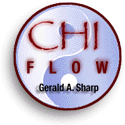


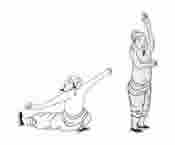
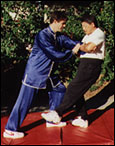 stories point to Yang Luchan's natural ability as the key to him becoming an excellent student that could not be turned away. Chen Changxing seems to have been able to take Yang Luchan to a higher level of practice than most of the Chen family members that he taught. Despite his persistence and physical gifts, like everyone else that has studied T'ai Chi Ch'uan, Yang Luchuan would hit many ceilings and plateaus during his study with Chen Changxing. It seems that Chen was able to impress upon Yang the finer points of practicing internally at all costs. Over time, the jewels of the art of T'ai Chi Ch'uan are often more about what is given up and less about what is gained.
stories point to Yang Luchan's natural ability as the key to him becoming an excellent student that could not be turned away. Chen Changxing seems to have been able to take Yang Luchan to a higher level of practice than most of the Chen family members that he taught. Despite his persistence and physical gifts, like everyone else that has studied T'ai Chi Ch'uan, Yang Luchuan would hit many ceilings and plateaus during his study with Chen Changxing. It seems that Chen was able to impress upon Yang the finer points of practicing internally at all costs. Over time, the jewels of the art of T'ai Chi Ch'uan are often more about what is given up and less about what is gained.